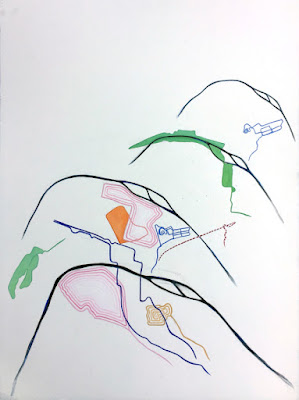Guest Blog: Lucinda Bliss
A week after returning home from Paris, I packed up the car
for a three-week residency at VCCA. On route down, I spontaneously veered off
track to see the Antietam National Battlefield, in Sharpsburg, Maryland.
Getting to know the land and the echoes it carries is part of my creative
practice, and I drove south filled with questions about how the history of the
country would feel different, and be held differently, from the southern
perspective, particularly in a period in our history when we (once again) seem to
be growing increasingly divisive.
With 23,000 soldiers killed or wounded, Antietam was the
bloodiest one-day battle in American history. Though the September 17, 1862
battle was supposedly not won by either side (the guide at the welcome center
was emphatic about this), it was claimed as a Union victory and
inspired Lincoln’s strategic Emancipation Proclamation.
I
had just returned from Paris a few weeks before my trip to Virginia and
hadn’t really begun to process my experience of the November 13 attacks (The Runner’s Glance in Paris). As I
navigated the Antietam grounds, it felt right to be
reminded of the deeper history of human violence, particularly as I
prepared to enter the protected creative space at VCCA that would allow me to
begin to translate my recent experiences through creative process.
After a few days of settling in and meeting the exceptional
group of writers, composers, and artists at the residency, I set off to run the
Monticello Holiday Classic 5k on the historic site where Thomas Jefferson built
his home. I left on a frosty morning before dawn, arriving on the site as the
sun was rising. Chatting up runners at local races is a great way to learn
about a place, in addition to getting a tactile experience of the
land. Since my days studying Art History at Skidmore College, I’d been
curious about Thomas Jefferson, impressed with his inventions,
progressive values, and commitment to creative enterprise, and disgusted by
his lifelong racism and misogyny. I was eager to see how the complicated man
would be represented at the national historic site.
In
the early hours of the morning, runners warmed up through the hilltop
gardens, preparing for the starting gun. The race itself was rough–the air
chilled my lungs and the course was filled with twists and turns.
Still, I placed 2nd in my age group, which earned
me a free ticket for a guided tour of the main house.
Thankfully,
our guide spoke about the darker side of Jefferson’s narrative and
incorporated stories of the lives of a few of the many slaves who worked
at Monticello during the President’s lifetime. The architecture, design of the
garden and grounds, and the natural site are spectacular. As our tour
concluded, the guide instructed us to head over to the fish pond (where fish
had been kept in “storage” during Jefferson’s time) for the iconic
reflection shot. As I continued to meander the grounds, I started thinking
about classical models of architecture and design–how that application of
proportion relative to the human body works, literally works, vibrating through the
body with a balance of form, light, and negative space. At the same time,
the authority signified by that very kind of structure points to the darker
history of domination and oppression. I remain in awe of Monticello
and fascinated by the contradictions it embodies. I’m holding in
mind the more than 200 slaves that lived, worked, gave birth, and died in
service of one man’s brilliant, complicated interpretation of classical and
humanist ideals.
These are the kinds of contradictions that I try to hold onto
when I return from a research exploration, and in the studio I
attempt to build a mark-making vocabulary that can speak to
multiple perceptions, in response to my experience of place.




Comments